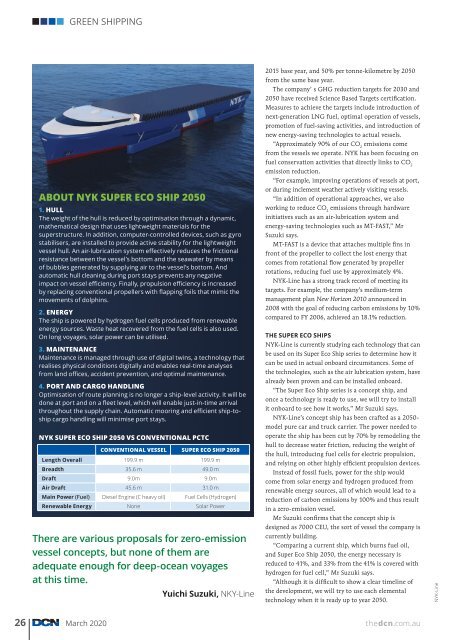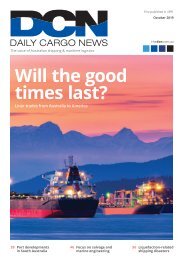DCN March Edition 2020
Create successful ePaper yourself
Turn your PDF publications into a flip-book with our unique Google optimized e-Paper software.
GREEN SHIPPING<br />
ABOUT NYK SUPER ECO SHIP 2050<br />
1. HULL<br />
The weight of the hull is reduced by optimisation through a dynamic,<br />
mathematical design that uses lightweight materials for the<br />
superstructure. In addition, computer-controlled devices, such as gyro<br />
stabilisers, are installed to provide active stability for the lightweight<br />
vessel hull. An air-lubrication system effectively reduces the frictional<br />
resistance between the vessel’s bottom and the seawater by means<br />
of bubbles generated by supplying air to the vessel’s bottom. And<br />
automatic hull cleaning during port stays prevents any negative<br />
impact on vessel efficiency. Finally, propulsion efficiency is increased<br />
by replacing conventional propellers with flapping foils that mimic the<br />
movements of dolphins.<br />
2. ENERGY<br />
The ship is powered by hydrogen fuel cells produced from renewable<br />
energy sources. Waste heat recovered from the fuel cells is also used.<br />
On long voyages, solar power can be utilised.<br />
3. MAINTENANCE<br />
Maintenance is managed through use of digital twins, a technology that<br />
realises physical conditions digitally and enables real-time analyses<br />
from land offices, accident prevention, and optimal maintenance.<br />
4. PORT AND CARGO HANDLING<br />
Optimisation of route planning is no longer a ship-level activity. It will be<br />
done at port and on a fleet level, which will enable just-in-time arrival<br />
throughout the supply chain. Automatic mooring and efficient ship-toship<br />
cargo handling will minimise port stays.<br />
NYK SUPER ECO SHIP 2050 VS CONVENTIONAL PCTC<br />
CONVENTIONAL VESSEL SUPER ECO SHIP 2050<br />
Length Overall 199.9 m 199.9 m<br />
Breadth 35.6 m 49.0 m<br />
Draft 9.0m 9.0m<br />
Air Draft 45.6 m 31.0 m<br />
Main Power (Fuel) Diesel Engine (C heavy oil) Fuel Cells (Hydrogen)<br />
Renewable Energy None Solar Power<br />
There are various proposals for zero-emission<br />
vessel concepts, but none of them are<br />
adequate enough for deep-ocean voyages<br />
at this time.<br />
Yuichi Suzuki, NKY-Line<br />
2015 base year, and 50% per tonne-kilometre by 2050<br />
from the same base year.<br />
The company’ s GHG reduction targets for 2030 and<br />
2050 have received Science Based Targets certification.<br />
Measures to achieve the targets include introduction of<br />
next-generation LNG fuel, optimal operation of vessels,<br />
promotion of fuel-saving activities, and introduction of<br />
new energy-saving technologies to actual vessels.<br />
“Approximately 90% of our CO 2<br />
emissions come<br />
from the vessels we operate. NYK has been focusing on<br />
fuel conservation activities that directly links to CO 2<br />
emission reduction.<br />
“For example, improving operations of vessels at port,<br />
or during inclement weather actively visiting vessels.<br />
“In addition of operational approaches, we also<br />
working to reduce CO 2<br />
emissions through hardware<br />
initiatives such as an air-lubrication system and<br />
energy-saving technologies such as MT-FAST,” Mr<br />
Suzuki says.<br />
MT-FAST is a device that attaches multiple fins in<br />
front of the propeller to collect the lost energy that<br />
comes from rotational flow generated by propeller<br />
rotations, reducing fuel use by approximately 4%.<br />
NYK-Line has a strong track record of meeting its<br />
targets. For example, the company’s medium-term<br />
management plan New Horizon 2010 announced in<br />
2008 with the goal of reducing carbon emissions by 10%<br />
compared to FY 2006, achieved an 18.1% reduction.<br />
THE SUPER ECO SHIPS<br />
NYK-Line is currently studying each technology that can<br />
be used on its Super Eco Ship series to determine how it<br />
can be used in actual onboard circumstances. Some of<br />
the technologies, such as the air lubrication system, have<br />
already been proven and can be installed onboard.<br />
“The Super Eco Ship series is a concept ship, and<br />
once a technology is ready to use, we will try to install<br />
it onboard to see how it works,” Mr Suzuki says.<br />
NYK-Line’s concept ship has been crafted as a 2050-<br />
model pure car and truck carrier. The power needed to<br />
operate the ship has been cut by 70% by remodeling the<br />
hull to decrease water friction, reducing the weight of<br />
the hull, introducing fuel cells for electric propulsion,<br />
and relying on other highly efficient propulsion devices.<br />
Instead of fossil fuels, power for the ship would<br />
come from solar energy and hydrogen produced from<br />
renewable energy sources, all of which would lead to a<br />
reduction of carbon emissions by 100% and thus result<br />
in a zero-emission vessel.<br />
Mr Suzuki confirms that the concept ship is<br />
designed as 7000 CEU, the sort of vessel the company is<br />
currently building.<br />
“Comparing a current ship, which burns fuel oil,<br />
and Super Eco Ship 2050, the energy necessary is<br />
reduced to 41%, and 33% from the 41% is covered with<br />
hydrogen for fuel cell,” Mr Suzuki says.<br />
“Although it is difficult to show a clear timeline of<br />
the development, we will try to use each elemental<br />
technology when it is ready up to year 2050.<br />
NYK-Line<br />
26 <strong>March</strong> <strong>2020</strong><br />
thedcn.com.au
















